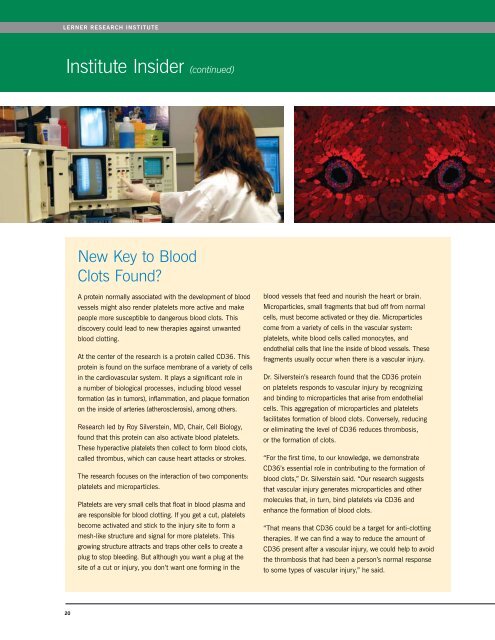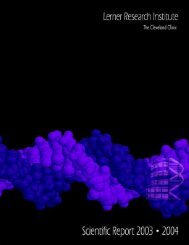<strong>Lerner</strong> research institute<strong>Institute</strong> Insider (continued)New Key to BloodClots Found?A protein normally associated with the development of bloodvessels might also render platelets more active and makepeople more susceptible to dangerous blood clots. Thisdiscovery could lead to new therapies against unwantedblood clotting.At the center of the research is a protein called CD36. Thisprotein is found on the surface membrane of a variety of cellsin the cardiovascular system. It plays a significant role ina number of biological processes, including blood vesselformation (as in tumors), inflammation, and plaque formationon the inside of arteries (atherosclerosis), among others.<strong>Research</strong> led by Roy Silverstein, MD, Chair, Cell Biology,found that this protein can also activate blood platelets.These hyperactive platelets then collect to form blood clots,called thrombus, which can cause heart attacks or strokes.The research focuses on the interaction of two components:platelets and microparticles.Platelets are very small cells that float in blood plasma andare responsible for blood clotting. If you get a cut, plateletsbecome activated and stick to the injury site to form amesh-like structure and signal for more platelets. Thisgrowing structure attracts and traps other cells to create aplug to stop bleeding. But although you want a plug at thesite of a cut or injury, you don’t want one forming in theblood vessels that feed and nourish the heart or brain.Microparticles, small fragments that bud off from normalcells, must become activated or they die. Microparticlescome from a variety of cells in the vascular system:platelets, white blood cells called monocytes, andendothelial cells that line the inside of blood vessels. Thesefragments usually occur when there is a vascular injury.Dr. Silverstein’s research found that the CD36 proteinon platelets responds to vascular injury by recognizingand binding to microparticles that arise from endothelialcells. This aggregation of microparticles and plateletsfacilitates formation of blood clots. Conversely, reducingor eliminating the level of CD36 reduces thrombosis,or the formation of clots.“For the first time, to our knowledge, we demonstrateCD36’s essential role in contributing to the formation ofblood clots,” Dr. Silverstein said. “Our research suggeststhat vascular injury generates microparticles and othermolecules that, in turn, bind platelets via CD36 andenhance the formation of blood clots.“That means that CD36 could be a target for anti-clottingtherapies. If we can find a way to reduce the amount ofCD36 present after a vascular injury, we could help to avoidthe thrombosis that had been a person’s normal responseto some types of vascular injury,” he said.20
Focusing on the patients of tomorrow FALL <strong>2008</strong>First Cross-Race Link in Arterial Disease, Heart Attack FoundA year ago, researchers found that a cluster of genetic variantson a specific region of chromosome 9 is linked to coronaryartery disease (CAD) in white people in northern Europe andNorth America. People who have that genetic quirk are moresusceptible to developing CAD or having a heart attack.Now, <strong>Institute</strong> researchers have shown the same geneticmaterial also is associated with coronary artery diseases inthe South Korean population — the first evidence of cross-racesusceptibility to CAD associated with the same specificcombination of genetic variants.CAD is a condition in which plaque builds up inside thecoronary arteries that supply heart muscle with oxygen-richblood. Plaque narrows the coronary arteries and reduces bloodflow to heart muscle. It also makes it more likely that bloodclots will form in arteries. CAD can lead to angina, heart attack,heart failure and arrhythmias (irregular heartbeats). It is themost common type of heart disease and the leading causeof death in the United States for both men and women. Bothgenetic and environmental factors — and the interplay betweenthe two — have been identified as major risk factors for peopledeveloping CAD. But the molecules and genes that contributeto the genetic risk have remained largely unidentified.At the center of the research are four single-nucleotidepolymorphisms (or SNPs) that are at a specific location on the 9p21piece of chromosome 9. Each SNP is a single DNA building block.SNPs occur normally throughout a person’s DNA, which meansthere are roughly 10 million SNPs in the human genome. MostSNPs have no effect on health or development. But when SNPsoccur within a gene or in a regulatory region near a gene, they mayplay a more direct role in disease by affecting the gene’s function.In this case, the presence of these four SNPs on 9p21 seem tobe associated with CAD, meaning people who have these fourspecific SNPs on their 9p21 gene have a higher risk of developingcoronary disease or suffering a heart attack.<strong>Research</strong> led by Qing Wang, PhD, Molecular Cardiology andDirector of the Center for Cardiovascular Genetics, took what isknown about the 9p21 SNPs in the white population and appliedit to 611 South Koreans who were diagnosed with CAD and 294healthy control patients.The researchers found a similar association between the 9p21SNPs and a higher risk of developing coronary disease andsuffering heart attacks among Asians.“Identifying specific ‘hot spots’ that might harbor one or moregenes that could influence development of CAD and showing thatit is a cross-race risk is an important advance in being able togenetically screen for coronary and arterial diseases or heartattacks,” Dr. Wang said. “Proving this association across diversehuman populations can lead to new clinical markers for diseasewhich can alert people about their risk of CAD or heart attackyears before any actual diseases develop. Early screening canlead to people making lifestyles changes to reduce the risk andearlier monitoring for potential health problems.”Magnets Could Save Stitch in Time for SomeHeart Valve Patients<strong>Research</strong>ers are investigating a replaceable heart valve that usesmagnets rather than stitches to keep the valve in the properposition, an innovation that will mean shorter surgeries, less timefor patients on heart-lung bypass machines, and reducing therisk of postoperative complications.During the last 40 years, there’s been significant progressin heart valve design and replacement procedures, with lifeexpectancy of about 20 years for the valves themselves. Butfailed valves require replacement surgery. In some cases, hearttissue can interfere with the replacement valve’s performanceby growing into it, a condition known as ingrowth.Kiyotaka Fukamachi, MD, PhD, Biomedical Engineering, isdeveloping a new heart valve that uses magnetic coupling to keepthe valve in the proper position. The prototype has two parts: abase magnet that is connected to a heart tissue with sutures, anda magnetic ring with the actual valve. Both are neodymium ironboron magnets encased in very thin stainless steel.During the initial surgery, sutures are used to connect the basemagnet to the fibrous tissue that encircles the opening with thefaulty natural valve. The magnet ring with the new valve is then“mated” to the base magnet without sutures or other permanentattachment techniques — two opposites being attracted to eachother. The two magnets remain connected even under greaterthan-normalpressure.The research team also designed a special separation toolcapable of detaching the magnets. Each ring has a beveled edgearound the outside edges. Should a repeat replacement beneeded, the blades of the tool can be placed in this groove —and squeezing the tool like a pair of scissors exerts enough forceto separate the rings. A new ring valve can then be “mated”quickly and easily to the base magnet that remains suturedto the heart tissue.21
















